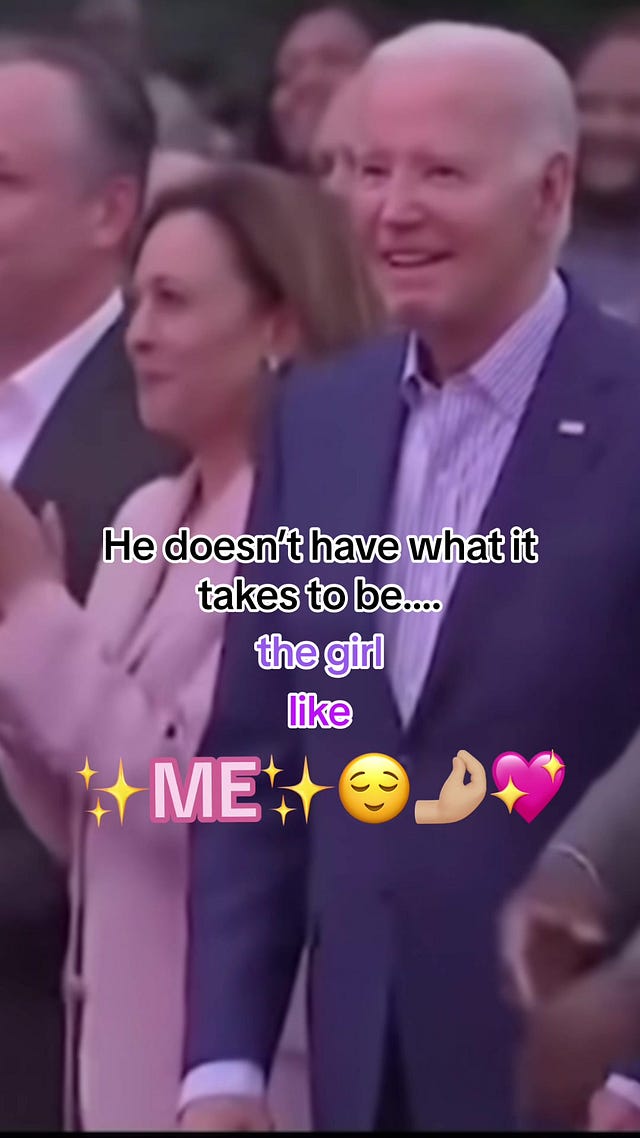🤣 🤭 How memes are reshaping human connection
From Dawkins to TikTok: classifying how memes bring us together
Read The Washington Post’s recent coverage of our new research on Front Porch Forum with the Center for Media Engagement
Memes have always been a part of life online — a form of comedy native to social media and its predecessors. Recently, with Kamala Harris’s campaign for president, and then the Paris Olympics, certain platforms seem to be white hot with radiant viral energy, almost like some latent meme power was being released.
I think we’re living in a fascinating moment: the channels for reaching people are arguably more fractured and niche than they have been in many decades, but there’s also widespread fear and skepticism of the dominant social media platforms. So now, Harris is running with the help of fancams and viral memes on TikTok, while at the same time, a ticking clock on a forced sale or ban of the app — signed into law by her boss, President Biden — continues to run down. Strange times!
Here, our former Fellow Stephanie Rodriguez expands on a typology of memes, based on some of her PhD research at the London School of Economics. Where did the idea of a “meme” come from anyway? And what are the different flavors? Steph unpacks the deep emotional resonance that’s possible to achieve with some kinds of memes, and how others are just funny.
–Josh Kramer, Head of Editorial, New_ Public
The power of the meme
We have all been there: gripped in a doom-scroll until you encounter a meme so funny it triggers an instantaneous belly laugh, or at least a grin. You immediately have to share it with a friend who you know would “just get it” too. The simple, yet strikingly effective act of sharing memes is play and bonding in motion, a moment of mutual validation, and often, joy.
Sharing a meme is a small yet mighty moment that reminds us of our shared humanity. Memes can cumulatively build a sense of compassion, respect, and belonging between people. They nurture the bonds that make up our social fabric. It’s in these magical and seemingly innocuous moments that we celebrate our shared understanding of the world, no matter how silly or ridiculous.
The origin of the meme dates back to 1976 when evolutionary biologist Richard Dawkins gave the name to the “small units of culture that spread from person to person by copying or imitation,” as Limor Shifman wrote in Memes in Digital Culture. This term has since taken on a life of its own in the digital world, where memes thrive.
The internet is now replete with memes! Over the years they have taken a variety of forms, but a few primary features remain consistent: they are rich in imagery, often layered with text, often pastiche, and always humorous. Meme formats range across GIFs, images layered with text or cleverly captioned, and videos.
Like a digital nod acknowledging agreement or mutual understanding, meme-sharing can be a validating moment where both parties benefit from feeling fully “seen” and can get a laugh out of it. As meme researcher Florian Schlittgen aptly describes it:
“Relatable memes” are characterized by their ability to trigger a moment of identification in the viewer, one that creates a feeling of “sameness”, expressed in statements such as “This is literally me!”, “Same” or “Relatable”.
There are at least three types of connections that can be forged through meme-sharing: bonding over a shared interest such as movies, sports, and more; bonding over an experience or circumstance; or bonding over a feeling or personal sentiment.
Connecting over interests
Sharing memes to connect over common interests is perhaps the most surface-level form of meme-sharing. It hinges exclusively on having shared cultural references rather than shared personal commonalities. These exchanges are more likely to occur in established relationships, such as among family and friends that have shared lived experiences and therefore are exposed to the same cultural references and social cues.
Alternatively, memes like this can go over the heads of most viewers while hitting the bullseye with a small subset. Platforms like TikTok, which excels at delivering extremely niche content to each user, can help find an audience for even the weirdest, most specific references.
Above is a great example of cultural cross-referencing: a nod to both Meryl Streep’s famous monologue from The Devil Wears Prada and Beyoncé’s daughter, Blue Ivy, brought together with a great candid photo. It’s only funny if you understand the cultural references (and to those that do — we can all agree that this is indeed a tasteful, culturally cross-referenced piece of content *chef’s kiss*).
Shared interests can be anything; spanning TV, movies, music, books, food, sports, and so much more, and therefore can easily serve as an effective icebreaker between strangers. Though this kind of meme-sharing can serve as a quick-fire means for forging connections, it might not be the most resonant or impactful.
Connecting over experiences
Connecting over a shared interest can be like connecting over a single data point. But people are so much more complicated. That is why connecting over experiences, which are often inherently more rich and embedded with memories and emotion, can yield a more powerful connection. For example, the topic of women protecting themselves against being assaulted on the street may not seem like fodder for a hilarious meme. And yet, the meme below made me feel, if only for a moment, empowered.
With the suggestion that behaving like a wild animal could in fact be an effective safety strategy against assault, I was granted a momentary reprieve from chronic fear for my safety. I immediately shared this with my closest friends, and we all shared in a virtual laugh: 😂 😂 😂. “If only it was that easy!” a friend replied.
Those who relate to this might recall a particular night out walking home with friends and the feeling of helplessness or fear that came with it — that is powerful. In this way, sharing memes to connect about a shared experience, situation, event, or circumstance can elicit stronger feelings than a shared interest in a restaurant, TV show, or song.
Connecting over feelings (#tfw)
Connecting over shared feelings can be even more moving. There is something particularly intimate about connecting over emotions, and at the same time, universal. As humans, we are rarely self-aware of all of our internal thoughts and feelings, so a meme that can connect with them unexpectedly, like the one below (sound on!), can be powerful.
Sharing emotional states is the act of connecting with those who share the same “feeling rules”, as renowned sociologist Arlie Hochschild calls it. More often than not, these emotional states are experienced in private moments, and by bonding over shared feeling rules people are cultivating a sense of solidarity in the very human experience of feeling.
We all feel and experience emotions, so in many ways forging this kind of connection can be deeply universalizing. Compared to bonding over a shared interest, this kind of bond can be a far more delicate sentiment to share casually. But the inherently comedic nature of memes lends itself well to lightheartedness, which can mask the sensitive emotions and complex empathy being forged. These memes extend the possibility for establishing these kinds of bonds with people beyond our loved ones and friends.
These three ways of forming connection through meme-sharing are of course not mutually exclusive, and they are far from being collectively exhaustive. There are definitely instances of meme-sharing which accomplish all of these: Many of the memes created about Kamala Harris combine cultural references (like songs by Chappell Roan or Charli XCX), a shared experience of waiting to see if Joe Biden would drop out, and a shared feeling of exuberance and political enthusiasm.
And there can also be situations in which people share memes for reasons outside of connecting over identity, experience, or feelings. Rather, what this typology illustrates is the ways that we can (and do!) cultivate belonging with others online through the sharing of comedic imagery.
Building a shared sense of humanity
Memes aren’t a panacea for everything that’s wrong with the internet. It’s worth acknowledging that as much as memes can foster belonging, they can also do so at the expense of others. It’s too easy to punch down and propagate harmful narratives. And some online groups trade memes that perpetuate authoritarianism, hate, or bigotry. That’s why New_ Public and others have been putting forward models to measure pluralism and determine which groups are oriented towards democratic outcomes.
Yet for the vast majority of people, memes can add emotionally-rich nuance to life online. They offer us opportunities to experience an all too rare sense of shared humanity. Relationship expert Esther Perel has said, “Comedy exposes hypocrisy, builds bridges, tells the truth like no other, speaks the unmentionable, punctures vanity, challenges falsehoods, and skewers prejudices; creates community and solidarity.” I invite you to think of the different ways you can use memes to share a moment of shared joy and solicit a moment of commonality, whether it be with a stranger, colleague, friend, or family.
Moving with care and awareness, give it a try! Send a lighthearted meme to someone you’ve been meaning to connect with on a deeper level and see where your commonalities take you. There is always something that we can share in common with others, even if it’s just our humanity.
– Stephanie Rodriguez
Thanks Steph!
Thinking about how much it would actually hurt to fall out of a coconut tree,
Josh










Recently, I heard Instagram’s CEO say that private messages are where the highest level of activity happens on the platform. He didn’t say it, but my hypothesis is that this is largely due to sharing memes with partners, family, friends, etc. Personally, in my case, my sister and I send each other dozens of memes a day across all social media without even saying a word. Just links, and I think it’s something quite common nowadays because sharing a meme is a way to show affection/interest in the other person.
I wish that there had been some nuance and consideration of the superficiality to the sort of "social bond" that comes from sharing a meme.